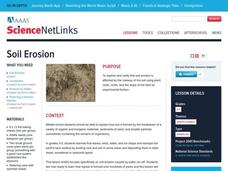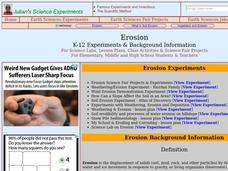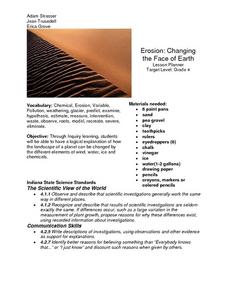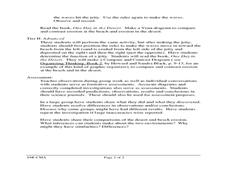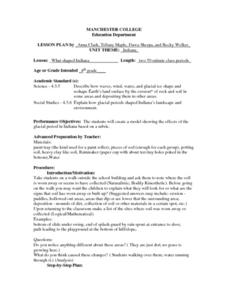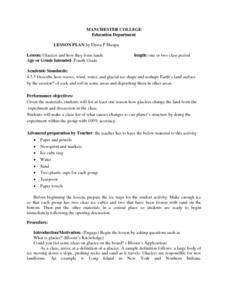University of Southern California
Wave Erosion Lab
Using a stream table, erosion enthusiasts examine how the density of sediment and how the slope of land contribute to the amount moved by waves. You will not be able to use this entire resource as is; there are teachers' names and...
Science 4 Inquiry
Let's Get Moving
Rivers top the list of causes of erosion over time. Scholars experiment with wind, water, and ice reshaping sand. They connect the simulations facts about erosion and deposition to understand unique landforms such as the Grand Canyon and...
Curated OER
Erosion and Deposition
Fifth graders study the processes of erosion, transportation, and deposition in soil. They walk outside the school to see examples and then accurately create a physical model which shows each type of soil movement and allows them to...
Curated OER
Soil Erosion
Students examine how erosion is affected by the composition of the soil and the slope of the land. They look at plant roots, rocks and land slope as experimental factors. They complete the associated worksheets before discussing their...
Curated OER
Erosion: Slip Sliding Away
Fourth graders investigate the causes of erosion. Through several demonstrations including one using sugar cubes and warm water, they observe the effects of erosion. In groups, 4th graders conduct similar experiments and record their...
Curated OER
Erosion: On the Move...Defending the Coast Against Wave Attack
Students study how people have tried to save beaches from wave erosion. They examine what has occurred to Cape Hatteras as a result of beach erosion and the efforts to reduce the erosion.
Curated OER
What Are Erosion and Sediments?
Students create experiments in class based on the erosion of Earth. In this erosion lesson, students perform a lab in class replicating the effects of erosion. Students finally draw their own conclusions based on the research performed.
Curated OER
Erosion
Students examine soil erosion and what causes it. In this soil lesson students complete several experiments on soil erosion and the weathering process.
Curated OER
Erosion: Changing the Face of Earth
Fourth graders explore how the landscape of the planet can be changed by different elements of wind, water, ice and chemicals through hands-on activities. They examine pictures of areas around town and discuss anything they think is out...
Curated OER
COASTAL EROSION
Students study the coastal erosion or the deposition by waves and sea level rise at a particular area.
Curated OER
Earth Science
Students explore how water and waves erode the earth. For this erosion lesson students determine the processes of wave erosion and building.
Curated OER
The Physical Environment
Fourth graders use damp sand, a baking pan, and water to simulate erosion. For this erosion lesson plan, 4th graders participate in a simulation to show what moving water does to land.
Curated OER
Coastal Surveys
Students investigate the human impact on coastal land. In this coastal surveys lesson plan, students choose a coastal area and complete a survey sheet about the area. They choose a topic about a sea side village called Dunwich to prepare...
Curated OER
Where's the Beach?
Students use beach profile data to analyze how erosion and sediment transport changed seashore slopes. In this geology lesson, students plot the data provided and analyze erosion patterns. They also assess coastal erosion management...
Curated OER
Coasts
Students explain the different types of marine coasts and where they are located in the United States and its territories. They explain and identify some of the life forms that inhabit different marine coastal regions.
Curated OER
Biomes: Coastlines and Seas
Students study the different types of coastlines and their territories. For this marine coasts lesson students identify life forms that are in the coastal regions.
Curated OER
Bhutan, the Last Shangri-La: Sandwich Squash: How the Himalayas Were Formed
Students create and record a model of mountain formation. They identify major mountain building formations. Students understand how the Himalaya Mountains were formed, why they are located near Bhutan, and why they are becoming larger.
Curated OER
Factors That Shaped Indiana
Fourth graders construct a model of Indiana which displays the effects of the glacial period on the state's physical structure. Students work in groups to plan and execute their model based on an established rubric.
Curated OER
The Effects of Volcanoes
Students use the internet to research the effects of volcanoes. They create a chart showing the negative and positive aspects that a volcanoe can bring to an area. Using PowerPoint, they create a presentation showing the negative and...
Curated OER
Glaciers and How They Form lands
As a whole class, the students define glacier and perform an experiment involving glaciers. The students brainstorm ideas of what a glacier is, and narrow the ideas down to a definition. The students then participate in an activity that...
Curated OER
Indiana Ice Investigations
Fourth graders create a model of the formation of Indiana by glaciers. Working in groups with appropriate materials, they create a model documenting how glaciers moved through the land and formed the geological structure and land masses...





